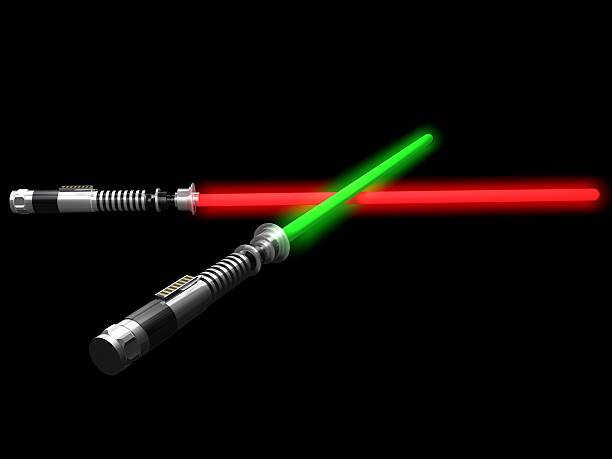The lightsaber, an elegant weapon for a more civilized age, has become one of the most iconic symbols in popular culture, originating from the “Star Wars” franchise. First introduced in George Lucas’s 1977 film “Star Wars: A New Hope,” the lightsaber has captivated the imaginations of millions of fans around the world. From its origins as a science fiction concept to its deep-rooted place in contemporary culture, the lightsaber has evolved significantly, both within the narrative universe of “Star Wars” and in the real world. This article delves into the history, symbolism, and cultural impact of the lightsaber.
The Origins of the Lightsaber
The lightsaber’s first appearance was in the hands of Obi-Wan Kenobi, who described it as “an elegant weapon for a more civilized age.” This description encapsulated the mystique and allure of the lightsaber, a weapon that was not just powerful but also graceful and sophisticated. The design of the lightsaber was inspired by a combination of fencing swords and samurai katanas, reflecting George Lucas’s fascination with both Western and Eastern martial arts traditions.
Lucas envisioned the Jedi as warrior monks, guardians of peace and justice who used their lightsabers in defense of the galaxy. The lightsaber itself was intended to be a symbol of their unique discipline and connection to the Force. It was a weapon that required not just physical skill but also a deep spiritual connection. This dual aspect of the lightsaber – as both a physical weapon and a metaphysical symbol – set it apart from other science fiction weaponry and made it an instantly recognizable element of the “Star Wars” mythos.
The Anatomy of a Lightsaber
A lightsaber consists of a plasma blade, powered by a Kyber crystal, which is emitted from a metal hilt. The blade is capable of cutting through virtually anything, except for another lightsaber blade. The Kyber crystal is a significant component as it determines the color of the blade. In “Star Wars” lore, the color of a Jedi’s lightsaber is often indicative of their role within the Jedi Order. For instance, blue lightsabers are commonly associated with Jedi Guardians, who focus on combat skills, while green lightsabers are associated with Jedi Consulars, who prioritize knowledge and diplomacy. Red lightsabers, in contrast, are typically wielded by Sith, who use synthetic crystals.
The design of the lightsaber hilt is also crucial. While the movies initially featured simple designs, later films and expanded universe content introduced a variety of lightsaber designs, from double-bladed sabers like Darth Maul’s to crossguard lightsabers like Kylo Ren’s. Each design reflects the personality and fighting style of its wielder, adding depth to the characterization of “Star Wars” heroes and villains.
Lightsaber Combat Styles
The use of lightsabers in combat is a defining feature of “Star Wars.” Within the lore, there are seven primary forms of lightsaber combat, each with its own unique techniques and philosophies.
- Form I: Shii-Cho – The oldest form, focusing on simple, sweeping motions. It is often the first form taught to young Jedi.
- Form II: Makashi – A dueling-centric style, characterized by precise and controlled strikes. Count Dooku is a notable practitioner of this form.
- Form III: Soresu – A defensive style that emphasizes blocking and deflecting blaster fire and other attacks. Obi-Wan Kenobi is a master of Soresu.
- Form IV: Ataru – An acrobatic and aggressive form that relies on agility and speed. Yoda and Qui-Gon Jinn are known for their use of Ataru.
- Form V: Shien/Djem So – A style that combines defensive techniques with powerful counterattacks. Anakin Skywalker and Luke Skywalker both utilize this form.
- Form VI: Niman – A balanced form that incorporates elements of the previous five forms. It is often used by Jedi who wish to focus on diplomacy rather than combat.
- Form VII: Juyo/Vaapad – A highly aggressive and unpredictable form that taps into darker emotions. Mace Windu developed Vaapad, a variation of Form VII, to channel his inner darkness.
These forms not only add depth to the lore but also influence how lightsaber duels are choreographed in the films, with each character’s fighting style reflecting their personality and inner struggles.
The Symbolism of the Lightsaber
Beyond its practical use in combat, the lightsaber is a potent symbol within the “Star Wars” narrative. It represents the dichotomy between light and dark, a theme that is central to the saga. The color of a lightsaber is often symbolic of its wielder’s alignment and personal journey. Blue and green lightsabers typically signify purity, hope, and justice, aligning with the Jedi’s role as peacekeepers. In contrast, red lightsabers, used by the Sith, symbolize anger, hatred, and a lust for power.
The process of constructing a lightsaber is also highly symbolic. In many “Star Wars” stories, a Jedi’s journey to find their Kyber crystal and build their lightsaber is a rite of passage, marking their transition from apprentice to knight. This journey is not only a test of their physical abilities but also their spiritual and emotional maturity. The lightsaber, therefore, becomes a reflection of the Jedi’s inner self, a tangible manifestation of their commitment to the Force.
Cultural Impact and Real-World Influence
Since its debut in 1977, the lightsaber has become a cultural icon, transcending the “Star Wars” franchise to influence a wide array of media and popular culture. The sound of a lightsaber igniting, the distinct hum, and the crackling clash of blades are instantly recognizable and have been replicated in various forms of entertainment, from movies and TV shows to video games and toys.
The lightsaber has also inspired real-world creations. Enthusiasts and engineers have attempted to build real-life lightsabers using plasma or high-intensity lasers, with varying degrees of success. While a true lightsaber, as depicted in “Star Wars,” remains a fictional concept due to the limitations of current technology, these efforts reflect the lightsaber’s powerful grip on the imagination of fans worldwide.
The weapon has also become a staple in fandom and cosplay. Lightsaber combat classes and clubs have sprung up around the world, where enthusiasts can learn choreographed fight sequences or even create their own. These activities serve not only as a form of entertainment but also as a community-building exercise, bringing fans together to celebrate their shared love of “Star Wars.”
The Future of the Lightsaber

As “Star Wars” continues to expand with new movies, TV series, books, and comics, the lightsaber remains a central element of its storytelling. New iterations of the weapon and its use continue to emerge, reflecting the evolving narrative and themes of the franchise. Shows like “The Mandalorian” and “Ahsoka” have introduced new lightsaber-wielding characters and unique variations of the weapon, such as the Darksaber, a black-bladed lightsaber with a unique design and history.
In the broader context of storytelling, the lightsaber’s enduring appeal lies in its dual nature. It is both a tool and a symbol, a weapon and a metaphor. It represents the eternal struggle between good and evil, light and dark, order and chaos. As long as “Star Wars” continues to explore these timeless themes, the lightsaber will remain at the forefront of its mythos.
Conclusion
The lightsaber is more than just a weapon; it is a cultural phenomenon that has captured the hearts and minds of millions. Its evolution from a simple science fiction prop to a symbol of hope, power, and identity is a testament to its unique place in both the “Star Wars” universe and our own. As technology and storytelling continue to evolve, the lightsaber will undoubtedly continue to shine brightly in the annals of pop culture, an everlasting symbol of adventure, heroism, and the battle between light and dark.





